可口可乐市场营销推广策略分析-SWOT分析-4P战略-波特五力模型
对可口可乐市场营销环境分析
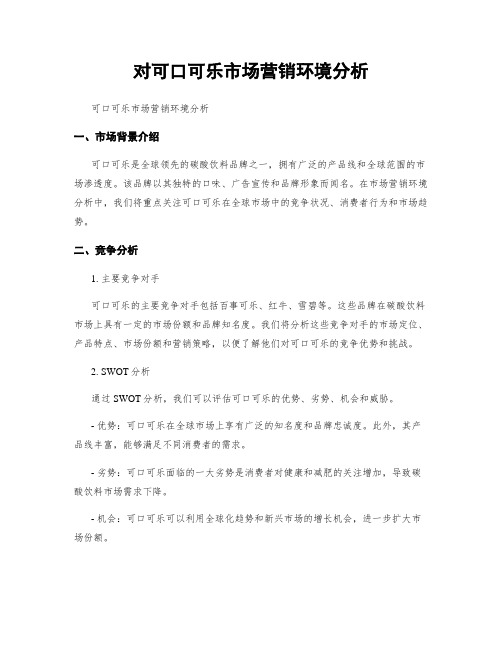
对可口可乐市场营销环境分析可口可乐市场营销环境分析一、市场背景介绍可口可乐是全球领先的碳酸饮料品牌之一,拥有广泛的产品线和全球范围的市场渗透度。
该品牌以其独特的口味、广告宣传和品牌形象而闻名。
在市场营销环境分析中,我们将重点关注可口可乐在全球市场中的竞争状况、消费者行为和市场趋势。
二、竞争分析1. 主要竞争对手可口可乐的主要竞争对手包括百事可乐、红牛、雪碧等。
这些品牌在碳酸饮料市场上具有一定的市场份额和品牌知名度。
我们将分析这些竞争对手的市场定位、产品特点、市场份额和营销策略,以便了解他们对可口可乐的竞争优势和挑战。
2. SWOT分析通过SWOT分析,我们可以评估可口可乐的优势、劣势、机会和威胁。
- 优势:可口可乐在全球市场上享有广泛的知名度和品牌忠诚度。
此外,其产品线丰富,能够满足不同消费者的需求。
- 劣势:可口可乐面临的一大劣势是消费者对健康和减肥的关注增加,导致碳酸饮料市场需求下降。
- 机会:可口可乐可以利用全球化趋势和新兴市场的增长机会,进一步扩大市场份额。
- 威胁:可口可乐面临的主要威胁包括竞争对手的市场份额增加、政府对碳酸饮料的监管加强以及消费者对健康食品的需求增加。
三、消费者行为分析1. 目标消费者群体可口可乐的目标消费者群体包括青少年、年轻成年人和家庭。
我们将分析这些目标消费者群体的消费习惯、购买决策因素、媒体使用偏好等,以便为可口可乐的市场营销活动提供指导。
2. 市场细分在市场细分中,我们将分析可口可乐的不同产品线针对不同消费者群体的定位和市场份额。
例如,可口可乐公司推出了针对健康意识较高的消费者的低糖和无糖饮料。
3. 消费者行为趋势随着社会的变化,消费者对饮料的需求也在不断变化。
我们将分析消费者对健康食品的关注度、可持续发展和环保意识的增强等趋势,以便可口可乐公司能够及时调整其产品和营销策略。
四、市场趋势分析1. 健康食品趋势随着人们对健康和健康饮食的关注不断增加,碳酸饮料市场面临着巨大的挑战。
可口可乐市场营销推广策略分析SWOT分析4P战略波特五力模型

Marketing Plan and Research Report of Coca-ColaTable of ContentExecutive summary (2)External environment analysis (2)Market strategy (6)Marketing research result (6)Marketing mix summary (7)Detailed strategy for promotion (9)Controls (11)Reference list (13)Executive summaryThe Coca-Cola Company (“Coca-Cola”) was founded in 1886 which is ranked number one in the beverage industry. The company manages more than 500 nonalcoholic beverage brands, and four of the top five nonalcoholic sparkling beverage brands are owned by Coca-Cola. According to its 2012 annual report, the whole group’s net operating revenue amounted to 48.02 billion USD (The Coca-Cola Company Annual Review, 2012). In addition, Coca-Cola accounts for approximately 37.1% of all the soft drink market, followed by PepsiCo at about 30.2%, and Dr. Pepper Snapple Group at 21.4% (Faber, 2012).In the long-standing viewpoint, Coca-Cola has an inclination to expand its market share to 50% and its sales revenue to 500 billion USD in the 2015 (Hofstede, 2012). Although its prosperous status quo, the company is also facing against an intensified competition. This report is aimed at analyzing the overall marketing strategy of Coca-Cola to find out the potential vulnerabilities. Then, based upon the analysis and in-depth research, it will outline the strategic plan for the future in order to further enhance Coca-Cola’s marketing status.External environment analysisA well-rounded analysis of company’s environment will be beneficial for the comprehensive understanding of the situation. First, it is better to research Coca-Cola’s external situation which includes three parts: macro-environmental factors, micro-environmental factors and competitive strategy.For the macro aspect, this report utilizes PEST model which examines the changes in a marketplace caused by Politics, Economy, Social and Technological factors.•Political AnalysisShifts of government’s attitude towards the foreign-invested enterprise may pose a threat to the company. Especially in the emerging countries, the political stability is essential to a successful business. In addition, changes of laws and regulations, including non-alcoholic drinks regulation should be considered.•Economic AnalysisAccording to IMF, while there have been some encouraging signs of economic recovery, the global economic growth seems to be losing momentum. In other words, the company still needs to be vigilant to the outside world and the emerging economy to seize opportunities.According to the Standard and Poor's Industry surveys, "For major soft drink companies, there has been economic improvement in many major international markets, such as Japan, Brazil, and Germany." These markets will continue to play a major role in the success and stable growth for a majority of the non-alcoholic beverage industry.•Social AnalysisLiving a healthier lifestyle is so prevalent all around world that has affected the non-alcoholic beverage industry as some consumers are switching to bottled water and diet colas instead of beer and other alcoholic beverages. This continued tendency will impact the non-alcoholic beverage industry by increasing the demand overall and in the healthier beverages.•Technological AnalysisThe rapid advancement of science and technology may deeply impact Coca-Cola as well. For example, novel distribution channel, diversified promotion campaign and new production line etc.In terms of micro-environmental factors, it is advisable to use Porter's Five Forces model to analyze the market condition.•Threat of new entrantsCompared with other industry, soft drinks industry has a relatively higher gross profit rate and lower barriers to entry, accordingly, there do exist many potential entrants. •Threat of substitute productsAs is mentioned above, healthier drinking has been a new trend for the consumers. So, enough attention must be paid to the substitute products such as tea drinks, bottled water and sports drinks.•Bargaining power of customerWith thousands kinds of non-alcoholic beverage in the market, consumers have a wide range of options. Additionally, they are also becoming sensitive to price which render them to have more bargaining power.•Bargaining power of suppliersAs the leading company in the market, Coca-Cola stays strong to the suppliers who are willing to collaborate with such a giant enterprise. In other words, bargaining power of suppliers is comparatively weak.•Intensity of competitive rivalryRelied upon its sales and distribution channels, Coca-Cola has undoubtedly established a mature marketing network. But what can’t be ignored is the threats posed by companies out of carbonated beverage, they all spare no effort to gain market share inBroadNarrow the relevant industry.After the analysis of the above two factors, keeping alert and further developing the core competency are extremely significant to Coca-Cola. Thus, how will the company compete with the major players in the market?Competitive AdvantageLower Cost DifferentiationAs can be seen in the chart, the company used differentiation and cost leadership tactics. Differentiation is achieved through superb quality of its product, which surpasses the company’s major rivals in the brand image and high customer recognition. What’s more, its promotion campaign and packaging strategy also differentiate Coca-Cola from competitors, for instance, its unique bottle design has become a world famous symbol.The positioning of cost leadership is achieved not only through economies of scale in research, development and promotion, but also through learning, knowledge and experience in production and operational processes. Furthermore, the company’s Cost LeadershipDifferentiation Cost Focus Differentiation FocusCompetitive Scopeefficient distribution networks and manufacturing systems contribute significantly to its cost saving..Market strategyBased on the above analysis, this report researches the interior part of Coca-Cola to determine its marketing and financial objectives, segmentation, positioning, and target market(s) in the future.Future growth for Coca-Cola will be embodied in two main areas: global emerging market health drinks. Besides United States Coca-Cola will continue to market to countries around the world. The company has an impressive performance in emerging markets like Latin America, the BRIC, and Western Europe which will be their major focus in the future for this is where major growth opportunities lie.In addition, consumers are moving towards a healthier lifestyle, which accordingly is causing Coca-Cola to expand product line to satisfy their needs. This new market is huge and creates a lot of growth opportunity for Coca-Cola.More specifically, Coca-Cola intends to increase its current market share in the soft drink to 50% in the end of 2015 (Hofstede, 2012), in particular, it will invest heavily in the health drink product to grab this developing cliché market and to cater for consumer’s aptitude. Then, the whole group will achieve 50 billion USD sales revenue and 13 billion USD profit margin (Marcial, 2007).Marketing research resultTo stay competitive, Coca-Cola has done well in understanding and satisfying consumers. It have been found that customers expect more from their beverages. To fill this desire Coca-Cola has developed the Beverage Institute for Health and Wellness. This institute develops new product ideas that can contribute to their product line. In addition, Coca-Cola is capable of maintaining their market vitality, so they continue to do research that will benefit their consumers, as well as being profitable for the company.Apart from flavor diversification, profitability in certain region has also been a major consideration. For instance, Coke Zero is a product that carries no carbohydrates orcalories and was not quite meeting the expected profits in the United States, but Coca-Cola started to advertise it more in Europe to areas that to enjoy it. This region seemed more concerned about their health and well-being, which contributed to Coke Zero becoming more of a profitable product.Special marketing techniques such as B2B strategies are also used to make their products more attractive to the young people. For example, Coca-Cola united with iTunes, so that whenever someone purchased a Coca-Cola product they would receive free songs to promote both products (Fuhrman, 2007).Even though, Coca-Cola is confronting with a number of challenges in the days to come. The most striking one is that the beverage industry is moving toward a health conscious consumer. “ In many European countries, the increasing consumer trend toward a healthier lifestyle continues to grow demand for functional beverages that offer physical or mental well-being, lower calories and other added values” (Fuhrman, 2007). Consumers’ value products that are going to help them live a healthy lifestyle and feel better both physically and mentally. Coca-Cola has to reconsider its existing product, pricing, distribution channel and promotion strategy to better adapt itself to the ever-changing atmosphere.In order to formulate a well-rounded market strategy for Coca-Cola, this report carefully establishes the relevant tactics which are in line with the analysis and data collected. It is recommended to use 4P which consists of product, place, price, promotion to analyze the specific details in the next part.Marketing mix summaryIn this report, 4P model is utilized to illustrate Coca-Cola’s marketing mix, i.e. product, place, price, promotion.Item DetailsProduct Coca-Cola has a huge product mix which contains about 400 brands, including diet and light beverages, waters, juice and juice drinks, teas,coffees, energy, and sports drinks (Coca-Cola Company, 2012).To attract new consumers and markets, product line must be extended,especially in the health drink product like tea, juice and sports drink etc.In addition, proper modification for the current product is also neededto maintain the current consumers.Price With the careful consideration of consumer’s price elasticity, the prices of the Coca-Cola's Companies products vary according to the brand andthe size in which they come in (Coca-Cola Company, 2012). Differentregion has differed preference and sensitivity to price. The distributorsand retail stores that the Coca-Cola Company deals with shouldimplement their own pricing strategy to gain the best profit marginwithin an accepted sales volume.Promotion There are four major parts of the promotional mix that integrate together to create a competitive advantage for an organization includingadvertising, public relations, sales promotion, and personal selling.Ads: Coca-Cola has invested heavily on advertising. The main purposeof ads are maintaining of brands awareness. Then, the ads in the futureshould focus on health conscious and environmentally friendly to caterfor the existing trend.Public relation: Product placements and sponsorships are frequentlyused by Coca-Cola (Marcial, 2007). Positive spokesperson to appeal tothe younger generation is another effective tool to publicize (Truini,2007)Personal selling: Personal selling in the Coca-Cola Company often isdone in a business-to-business fashion. This can be used in big businessalliance to satisfy consumers’ diversified needs.Sales promotion: coupons and rebates can be often used because theyare more likely to influence customers’ buying decision. Another typeof sales promotion that the Coca-Cola Company is currently using istheir coke rewards points promotion.Place Coca-Cola Company also uses intensive distribution strategies to makesure their products can be available everywhere. Moreover, automaticvending machines are effective to extend distribution network. To copewith the changing diet conception, Coca-Cola should focus more onCoca-Cola’s Diet Coke and Coke Zero sales, especially in LatinAmerica, the BRIC, and Western Europe (Fuhrman, 2007).Detailed strategy for promotionOnly with superior product, efficient distribution network and sufficient inventory is far from a successful business. Promotion is the key element of the marketing mix designed to build a useful channel with the marketplace and to persuade the customers buying decision. The promotional mix is the combination of personal selling, advertising, sales promotion and public relations that it uses in its marketing plan. •AdvertisingThe Coca-Cola’s innovative ads are extremely impressive to consumers. So, next step, what the company should do is keep this unique advantage and focus much more on the localization with respect to different culture background. This can be contributable to develop the emerging market.•Public relationSponsorship in the sport area has been successful in the last few decades and left a positive brand image. To comply with the healthy trend, Coca-Cola needs to invest more in public benefit activities, for instance, giving sponsor Hope Primary School, making contributions to medical treatment cause. These activity may establish a positive image in all kinds of people.•Personal selling & sales promotionThe negative implication of several media has exerted a relatively profound impact upon carbonated beverage. Accordingly, juice, tea and sports drinks should be the main products for promotions. The company can improve health drink market share by using more personal selling booth and more sales discount or lottery coupon. These activities are effective for getting people's short-term attention.Survey experiment in the Fenwick’s department store also proved the above analysis. In the survey of consumers’ attitudes towards health consideration when purchasing drinks, more than 45% agree with the viewpoints (as is shown in the bar chart below).In addition, when asked about familiarity, 50% agree with that it plays a major role in purchasing decision.ControlsImplementationImplementation is the process on how well the business mixes its people, organizational structure and company culture into a cohesive program that supports the marketing plan (Clark, 2005).Coca-Cola should implement several major transformations. First, production capability need to be modified to meet the quota demanded. It must also be cost-effective to avoid inventory stocks wastes. The marketing team should be aware of knowledgeable management about the product. The styles and types of promotion must be appealing to target customers to obtain the potential amount of exposure for the product. Another thing is efficient distribution network. The pertinent issue is taken care of with expedient transportation routes to commercial areas and traffic. Monitoring And ControllingMonitoring and controlling allows Coca-Cola to take the necessary actions to meet the marketing goals. There are three methods Coca-Cola may use to monitor the marketing scheme.•Sales AnalysisThe sales analysis analyzes sales revenue by market segmentation to discover advantages and disadvantages in the different regions. Sellers of Coca-Cola products vary from big retail supermarkets to small corner stores. This tool gives the products maximum exposure to customers at their convenience.•Market Share AnalysisThis approach is a comparison to the major rivals in the relevant market. With the shifts Coca-Cola is currently undergoing, they aim to get an aggressive position to stable its strong power. Target market various age groups and lifestyles from high school students too universities, and male or female.•Marketing Profitability AnalysisThis method takes the cost factor into consideration which deem profitability as a key index. Three ratios can be used for supervising marketing profitability; they are market research to sales, advertising to sales and sales representatives to sales. These three indicators can assist Coca-Cola determine any developing tendency, such as the requirement for a novel product. Scientific and careful comparison of these outcomes with actual results offers the company a clear instruction.Reference listAlarcon, Camille. (2007, January). Coke grows from zero to hero. B & T Weekly, 6-7 McKenzie, M., Linden, R. W. A., & Nicholson, J. W. (2009). The effect of Coca-Cola and fruit juices on the surface hardness of glass–ionomers and ‘compomers’.Journal of Oral Rehabilitation,31(11), 1046-1052.Belch, G. E., Belch, M. A., Kerr, G. F., & Powell, I. (2008).Advertising and promotion: An integrated marketing communications perspective. McGraw-Hill.Clark, Nicola. (2005). PowerAde eyes feminine appeal. Marketing, 16-17Flagg, Michael. (2002). Pepsi Siphons Off Some of Coke's Lead In China by Learning to Pick Its Battles.Wall Street Journal (Eastern Edition),23(5), 12-13. Fuhrman, E. (2007, September). Western Europe: A mature market. Beverage Industry, 98(9), 24-26.De Mooij, M. & Hofstede, G. (2010). Convergence and divergence in consumer behavior: implications for international retailing.Journal of retailing,78(1), 61-69.Harnack, L., Stang, J., & Story, M. (2004). Soft drink consumption among US children and adolescents: nutritional consequences.Journal of the American Dietetic Association,99(4), 436-441.MacArthur,Kate and Thompson, Stephanie.(2006). Pepsi, Coke: We satisfy your 'need states'.Advertising Age,77(3), 54-56.Marcial, G. (2007). Coke Sparkles Again. Business Week,15(2), 51-53.The Coca-Cola Company 2012 Annual Review, 12-15Truini, J. (2007). Beverage maker plans biggest plastics plant. Waste News, 13. (10), 4-4.Tucker, W. T. (2006). The development of brand loyalty.Journal of Marketing Research, 32-35.。
可口可乐公司饮料的SWOT分析
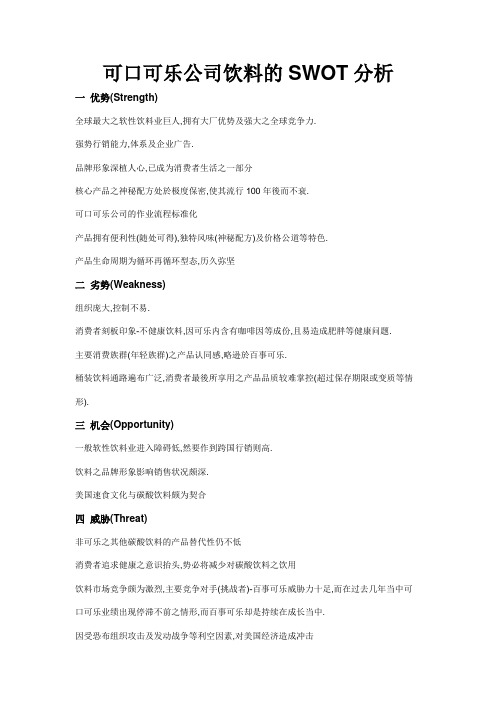
可口可乐公司饮料的SWOT分析一优势(Strength)全球最大之软性饮料业巨人,拥有大厂优势及强大之全球竞争力.强势行销能力,体系及企业广告.品牌形象深植人心,已成为消费者生活之一部分核心产品之神秘配方处於极度保密,使其流行100年後而不衰.可口可乐公司的作业流程标准化产品拥有便利性(随处可得),独特风味(神秘配方)及价格公道等特色.产品生命周期为循环再循环型态,历久弥坚二劣势(Weakness)组织庞大,控制不易.消费者刻板印象-不健康饮料,因可乐内含有咖啡因等成份,且易造成肥胖等健康问题.主要消费族群(年轻族群)之产品认同感,略逊於百事可乐.桶装饮料通路遍布广泛,消费者最後所享用之产品品质较难掌控(超过保存期限或变质等情形).三机会(Opportunity)一般软性饮料业进入障碍低,然要作到跨国行销则高.饮料之品牌形象影响销售状况颇深.美国速食文化与碳酸饮料颇为契合四威胁(Threat)非可乐之其他碳酸饮料的产品替代性仍不低消费者追求健康之意识抬头,势必将减少对碳酸饮料之饮用饮料市场竞争颇为激烈,主要竞争对手(挑战者)-百事可乐威胁力十足,而在过去几年当中可口可乐业绩出现停滞不前之情形,而百事可乐却是持续在成长当中.因受恐布组织攻击及发动战争等利空因素,对美国经济造成冲击在爆发一连串企业会计丑闻後,投资者渐失信心,要求美国企业财务透明化的声浪日益高涨五可长久之竞争优势(SCA)品牌优势及良好之企业形象.产品拥有神秘配方.市占率高且为产业优先进入者,领导者及防卫者研发能力及行销能力强.强势广告及通路.六可口可乐公司发展建议:在追求健康之时代潮流中,该公司势必须运用强大之研发能力适度改良产品成份,除保留可乐之原味(神秘配方)外,应剔除会影响健康之成份(或以其他成份代替),强调健康产品.运用现有品牌优势,开发新种产品,再次创造另一风潮.可透过合并或收购在其他国家之拥有独特且畅销产品的他种饮料厂商,使其在该国之产品线更加完备(诸如在台湾信喜实业所生产之开喜乌龙茶).透过强势广告,加强年轻族群(为主要消费族群)之产品认同感,以争取目前较喜欢百事可乐之年轻阶层10营销1班李颖仪201011022112。
可口可乐市场营销环境分析-SWOT

1. Coca-Cola的中文名
2. 差异化营销
3. 营销组合分析 4. 广告口号 5. 环境分析
6. SWOT分析
产有 品人 策的 地 略方 :
就 有 可 口 可 乐
价格策略:1元钱可 以做什么?1元钱可 以买1瓶可口可乐。
当然 随着物价上涨, 也得涨五毛了。
促销策略:铺货:以“三买”(3A)为营销,买得 到、买得起、乐意买。
第五,政治法律。 中国对于外国投资者还是比较欢迎的。中国制定了一系列保护外企的法律和出 台很多优惠外企的政策。
第六,竞争者。 一个产品必须知道,那些产品是自己的竞争者,而这些竞争者又采取了什么营 销策略。
可口可乐采用在城市中心做终端,由业务员到终端 拿单,由直营批发送货,对于城市边缘无法掌控的地区则由 自流批发负责自营送货。可口可乐成功地将网络建立起来以 后,对市场的掌控能力非常强。 可口可乐和百事可乐几乎占据了我国中型城市以上 的市场,他们在品牌传播、市场运作、销售体系、广告运用、 经销商管理等方面都达到了炉火纯青的地步。百事可乐从 2000年开始推广“表现自我,渴望从生活中获得更多” 的品 牌主张和核心价值。
1. 2. 3. 4. 5. 6.
Coca-Cola的中文名 差异化营销 营销组合分析 广告口号 环境分析 SWOT分析
可乐宣传 广告口号 2000 2001 2003 2010 2011 2013 心在跳!我们努力活出真精彩! Life tastes good。 激情在此燃烧。 你想和谁分享新年第一瓶可口可乐。 积极乐观 美好生活。 Open Happiness ( 开启快乐 )
2010 你想和谁分享新年第一瓶可口可乐
2011 积极乐观 美好生活
2013 Open Happiness ( 开启快乐 )
市场营销4p策略案例

市场营销4p策略案例案例:可口可乐公司的市场营销4P策略可口可乐公司是全球领先的饮料公司,其市场营销4P策略的成功应用是一个经典案例。
以下将介绍该公司在产品、价格、渠道和促销方面的策略。
1. 产品:可口可乐公司以其广受欢迎的可口可乐汽水为主打产品。
该产品具有独特的口感和可口可乐独特的风味,受到全球消费者的喜爱。
此外,公司还推出了多样化的产品线,如零度可乐、芬达等,以满足不同人群的口味需求。
2. 价格:可口可乐公司采用了多层次的定价策略。
在高端市场,公司通过定价较高的策略来强调品牌的高品质和独特性。
而在大众市场,公司则采用较低的定价来吸引更多的消费者。
此外,可口可乐公司还推出了不同规格的包装,以满足不同消费者的需求,并调整了包装和价格之间的关系,以提高消费者的购买欲望。
3. 渠道:可口可乐公司建立了一个庞大的分销网络,以确保产品能够覆盖更广泛的市场。
公司通过与零售商、便利店和超市的合作,将产品放置在易于找到和购买的地方。
此外,公司通过与快餐连锁店和酒吧合作,使产品在消费者的餐厅和休闲场所中更加易获取。
4. 促销:可口可乐公司在促销方面采取了多种策略。
首先,公司通过在电视、电影和体育赛事等广告渠道进行广告宣传,提高产品的知名度和影响力。
其次,公司还利用社交媒体等新媒体渠道,加强与消费者的互动,提高品牌忠诚度和口碑传播。
此外,可口可乐公司还举办品牌活动和体验活动,与消费者建立更深层次的联系。
通过以上4P策略的综合应用,可口可乐公司取得了巨大的市场成功。
该公司的产品具有明显的差异化特点和高度的品牌忠诚度,价格和渠道的合理制定和布局,使产品能够覆盖更广泛的消费者群体,并通过广告宣传和促销活动提高了品牌的认知度和影响力。
这些策略的成功应用为可口可乐公司的市场地位和竞争优势打下了坚实的基础。
可口可乐SWOT分析

学号:0120803530107财务战略管理题目可口可乐公司SWOT分析学院管理学院专业财务管理班级财务管理0801姓名谢常蓁指导教师石友蓉2011 年9 月25 日可口可乐SWOT分析一、可口可乐公司简介可口可乐公司(Coca-Cola Company)成立于1892年,总部设在美国乔亚州亚特兰大,是全球最大的饮料公司,拥有全球48%市场占有率以及全球前三大饮料的二项(可口可乐排名第一,百事可乐第二,低热量可口可乐第三),可口可乐在200个国家拥有160种饮料品牌,包括汽水、运动饮料、乳类饮品、果汁、茶和咖啡。
该公司2011年第二季财报的数据显示,盈利同比增长24%,盈利从上年同期的1.99亿美元升至2.46亿美元,许多投资者都做出全年盈利的展望。
二、SWOT分析1、优势(1)品牌悠久:可口可乐是1886年美国的潘柏顿大夫,利用古柯叶及可乐果所研发而成的。
一百多年来历久不衰且风行全世界。
品牌悠久,市场占有率大。
(2)大量制造,使成本降低:所有的可口可乐原汁都是在总公司制造,以浓缩后载运至世界各地的加工厂。
(3)良好的危机处理:1999年6月中旬,法国的消费者在饮用可口可乐后出现不适症状,随即在欧洲大陆引起公众的极度心理恐慌。
法国政府被迫宣布禁售可口可乐。
危机发生后,可口可乐公司立即着手调查中毒原因,发现法国的中毒事件是因为敦克尔克工厂的杀真菌剂洒在了储藏室的木托盘上而造成污染。
整个事件的过程中,可口可乐公司都牢牢地把握住信息的发布源,防止危机信息的错误扩散,将企业品牌的损失降低到最小的限度。
(4)概念创新:从广告我们可看出,可口可乐并不是营销单纯的饮料,而是爱情、青春,文化概念的上创新是它富有生命力。
且可口可乐不断在外型包装上创新,以刺激买气。
甚至有专卖店在卖可口可乐的瓶子及外围商品。
促使品牌的价值提高增加消费者的购买欲。
但是对于饮料本身的创新,对可口可乐而言并不是优势。
(5)顾客回应:例如「可口可乐」的目标市场一直都是年轻人,而因特网的发达,促使「可口可乐」利用其网站,让匿名的网友留下数据或意见,等他下次造访网站时,在运用追踪技术,纪录网友在网上从事的行为。
可口可乐竞争战略分析

什么是波特五力竞争模型?五力模型是由波特(Porter)提出的,它认为行业中存在着决定竞争规模和程度的五种力量,这五种力量综合起来影响着产业的吸引力。
它是用来分析企业所在行业竞争特征的一种有效的工具。
在该模型中涉及的五种力量包括:新的竞争对手入侵,替代品的威胁,买方议价能力,卖方议价能力以及现存竞争者之间的竞争。
决定企业盈利能力首要的和根本的因素是产业的吸引力。
分析饮料料行业的竞争态势---波特“五力模型”迈克尔·波特的理论建立在产业组织经济学的“结构——行为——绩效(SCP)”这一范式上,认为企业竞争优势是由产业结构决定的,是由一个产业中的五种竞争力量(即进入威胁、替代威胁、买方的议价能力、供应方的议价能力和现有竞争对手的竞争)所决定的,这五种基本竞争力量的状况及其综合强度,决定了行业的竞争激烈程度,从而决定了产业最终的获利潜力。
要对抗这些竞争力量,企业就要采取相应的发展策略,建立自己的竞争优势。
一、饮料行业的竞争态势近10年来,饮料工业的年产量以年均17%的速度快速增长,成为中国食品工业中最具潜力且发展速度最快的行业之一。
从国内饮料市场上近几年竞争情况看,主流产品“各领风骚一两年”,从1998年前的碳酸饮料到1999年的纯净水、从 2000年的茶饮料和2002年的新型果汁,到2003年的功能混合饮料,再到2008年的维生素饮料;消费热点更是变幻难测,果汁市场的日益兴旺,带来了消费形态和方式的分化,主要表现为以下特征:第一,饮料消费市场呈明显年轻化。
据新生代CMMS2000调查结果显示,饮料消费群体呈年轻化趋势。
第二,饮料产品种类呈多元化发展趋势。
企业纷纷根据消费者追求的健康、营养等消费理念,开发新型的果汁饮品,功能型饮料逐渐形成受中青年女性关注的饮料市场。
第三,饮料消费品牌特征明显。
消费者在选择上,注重的还是产品的口味、价格和品牌知名度这些基本要素。
国产饮料品牌价格适中,信誉度良好,品牌优势大,消费者对多数品牌满意度较高,但消费者品牌忠诚度较低。
可口可乐的五力模型分析
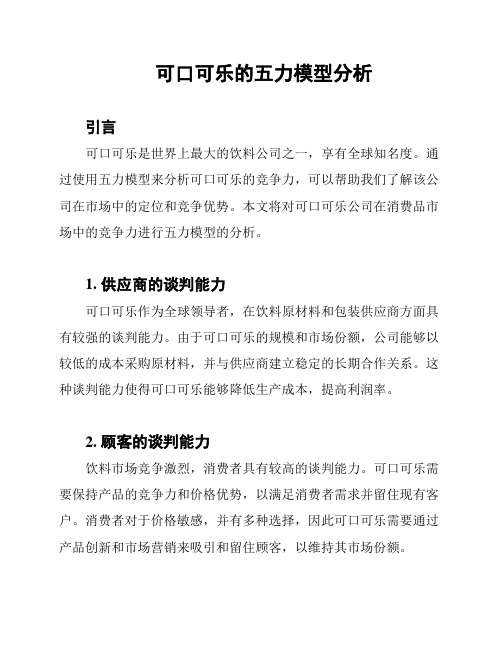
可口可乐的五力模型分析引言可口可乐是世界上最大的饮料公司之一,享有全球知名度。
通过使用五力模型来分析可口可乐的竞争力,可以帮助我们了解该公司在市场中的定位和竞争优势。
本文将对可口可乐公司在消费品市场中的竞争力进行五力模型的分析。
1. 供应商的谈判能力可口可乐作为全球领导者,在饮料原材料和包装供应商方面具有较强的谈判能力。
由于可口可乐的规模和市场份额,公司能够以较低的成本采购原材料,并与供应商建立稳定的长期合作关系。
这种谈判能力使得可口可乐能够降低生产成本,提高利润率。
2. 顾客的谈判能力饮料市场竞争激烈,消费者具有较高的谈判能力。
可口可乐需要保持产品的竞争力和价格优势,以满足消费者需求并留住现有客户。
消费者对于价格敏感,并有多种选择,因此可口可乐需要通过产品创新和市场营销来吸引和留住顾客,以维持其市场份额。
3. 其他竞争对手的威胁可口可乐在全球范围内面临来自其他大型饮料公司和品牌的竞争。
对于可口可乐来说,竞争对手的威胁是存在的,因为其他公司也有能力和资源来推出新产品并争夺市场份额。
可口可乐需要通过持续的创新和品牌建设来抵御竞争对手的威胁,并保持市场领导地位。
4. 新进入者的威胁虽然可口可乐在市场中占据着强大的地位,但新进入者的威胁依然存在。
对于新公司来说,进入饮料市场并与可口可乐竞争是具有挑战性的,需要面对高度竞争的环境和市场准入壁垒。
然而,可口可乐需要密切关注新进入者的崛起,并及时作出反应,以保持其市场份额和竞争优势。
5. 替代品的威胁在饮料市场中,替代产品的威胁也是一个重要因素。
例如,咖啡、茶和果汁等饮料也是消费者的选择。
可口可乐需要通过产品创新和广告宣传来区分和推广其产品,以减弱替代品的威胁,并确保消费者对可口可乐品牌的忠诚度。
结论通过五力模型的分析,可口可乐公司在消费品市场中具有较强的供应商谈判能力和品牌影响力,可以抵御竞争对手的威胁。
然而,该公司需要关注消费者的谈判能力、新进入者的威胁和替代品的竞争,以保持市场份额和竞争优势。
市场营销常用的分析工具介绍,SWOT、五力模型、4P4C理论
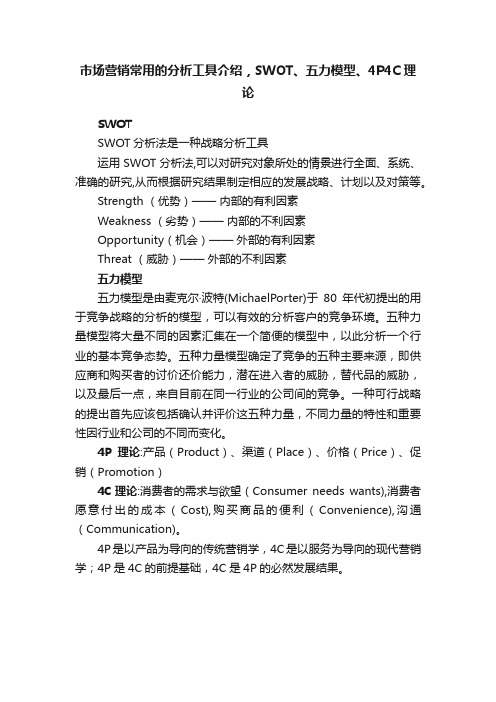
市场营销常用的分析工具介绍,SWOT、五力模型、4P4C理
论
SWOT
SWOT分析法是一种战略分析工具
运用SWOT分析法,可以对研究对象所处的情景进行全面、系统、准确的研究,从而根据研究结果制定相应的发展战略、计划以及对策等。
Strength (优势)——内部的有利因素
Weakness (劣势)——内部的不利因素
Opportunity(机会)——外部的有利因素
Threat (威胁)——外部的不利因素
五力模型
五力模型是由麦克尔·波特(MichaelPorter)于80年代初提出的用于竞争战略的分析的模型,可以有效的分析客户的竞争环境。
五种力量模型将大量不同的因素汇集在一个简便的模型中,以此分析一个行业的基本竞争态势。
五种力量模型确定了竞争的五种主要来源,即供应商和购买者的讨价还价能力,潜在进入者的威胁,替代品的威胁,以及最后一点,来自目前在同一行业的公司间的竞争。
一种可行战略的提出首先应该包括确认并评价这五种力量,不同力量的特性和重要性因行业和公司的不同而变化。
4P理论:产品(Product)、渠道(Place)、价格(Price)、促销(Promotion)
4C理论:消费者的需求与欲望(Consumer needs wants),消费者愿意付出的成本(Cost),购买商品的便利(Convenience),沟通(Communication)。
4P是以产品为导向的传统营销学,4C是以服务为导向的现代营销学;4P是4C的前提基础,4C是4P的必然发展结果。
可口可乐公司SWOT分析

可口可乐公司SWOT分析可口可乐公司诞生于1886年,总部在美国的亚特兰大,是世界软饮料销售的领袖和先锋,拥有近400种饮料品牌,畅销世界200多个国家和地区,每日销量超过15亿杯,占全世界软饮料市场的48%,并拥有全球最畅销软饮料品牌前五名的四个,包括可口可乐、健怡可口可乐、雪碧和芬达。
怡可口可乐、雪碧和芬达。
目前中国每年人均饮用可口可乐公司产品数量为24瓶(每瓶8盎司或237毫升)。
而中国也成为可口可乐公司全球第四大市场。
目前可口可乐中国系统员已超过30,000人,99%的员工为中国本地员工。
的员工为中国本地员工。
SWOT分析优势(Strength))品牌悠久(1)品牌悠久可口可乐自1886年成立以来,一百多年来经久不衰并且风行全世界。
品牌形象深入人心,已成为消费者生活的一部分心,已成为消费者生活的一部分(2)全球最大之软性饮料业巨人,拥有大厂优势及强大之全球竞争力. 产品更为市场之领导品牌 (3)具有高度的创新以及研发能力,市场占率高,产品更为市场之领导品牌(4)产品拥有便利性(随处可得),独特风味(神秘配方)及价格公道等特色. (5)强大的销售通路、销售网及营销策略,并拥有速食业(以麦当劳为首)的强大销售通路. 可口可乐公司的作业流程标准化. 劣势(Weakness) (1)主要消费族群(年轻族群)之产品认同感,略逊於百事可乐. (2)组织庞大,控制不易. )消费者的主观印象觉得可口可乐是碳酸饮料,且含有咖啡因,所以可能会导致一些健 (3)消费者的主观印象觉得可口可乐是碳酸饮料,且含有咖啡因,所以可能会导致一些健康问题,例如肥胖。
康问题,例如肥胖。
机会(Opportunity) (1)碳酸饮料较符合年轻族群需求,尤其为拉丁美洲和亚太国家,年轻人比例正快速提高,带给业者之商机颇高. (2)赞助各项体育赛事,例如奥运会,特奥会,NBA,世界杯等,也可以结合公益活动,塑造企业形象塑造企业形象)中国越来越盛行的快餐文化与碳酸饮料颇为契合(3)中国越来越盛行的快餐文化与碳酸饮料颇为契合威胁(Threat)(1)替代品(除了碳酸饮料之外的例如茶饮料、果汁等)的威胁大)替代品(除了碳酸饮料之外的例如茶饮料、果汁等)的威胁大(2)竞争者的威胁,主要的竞争对手百事可乐在加速成长中)竞争者的威胁,主要的竞争对手百事可乐在加速成长中(3) 消费者追求健康之意识抬头,势必将减少对碳酸饮料之饮用势必将减少对碳酸饮料之饮用可口可乐关键竞争要素分析关键竞争要素 权重权重 娃哈哈娃哈哈 农夫山泉农夫山泉 康师傅康师傅 统一统一 可口可乐可口可乐等级 加权分数分数 等级 加权分数分数 等级 加权分数 等级 加权分数分数 等级 加权分数分数S1 S1 品牌效应品牌效应品牌效应 0.1 4 0.6 3 0.3 S2 强大的销售网售网0.15 2.5 0.25 4 0.6 S3 创新研发能力能力0.15 4 0.2 4 0.6 S4 S4 大厂优势大厂优势大厂优势 0.1 3.5 0.353.5 0.35 S5 核心保密配方配方0.2 4 0.2 3 0.6 S6 S6 市场掌控市场掌控市场掌控 0.153 0.453 0.45 W1 消费者印象0.1 2.5 0.075 3.5 0.35 W2 产品认同感 0.05 3 0.15 总和总和 1.00 2.9753.4可口可乐关键环境因素分析关键环境要素 权重权重 娃哈哈娃哈哈 农夫山泉农夫山泉 康师傅康师傅 统一统一 可口可乐可口可乐 等级 加权分数分数 等级 加权分数分数 等级 加权分数 等级 加权分数分数 等级 加权分数分数O1公益活动公益活动 0.1 4 0.6 2.5 0.25 O2赞助赛事赞助赛事 0.2 2.5 0.25 4 0.8 O3快餐文化快餐文化 0.154 0.2 3 0.45 O4年轻族需求0.1 3.5 0.35 2.5 0.25 T1替代品威胁0.2 4 0.2 4 0.8T2消费者意0.15 3 0.45 3 0.45 识T3竞争者威0.1 2.5 0.075 2.5 0.25 胁总和 1.00 2.975 3.25 总和。
可口可乐市场营销环境分析-SWOT
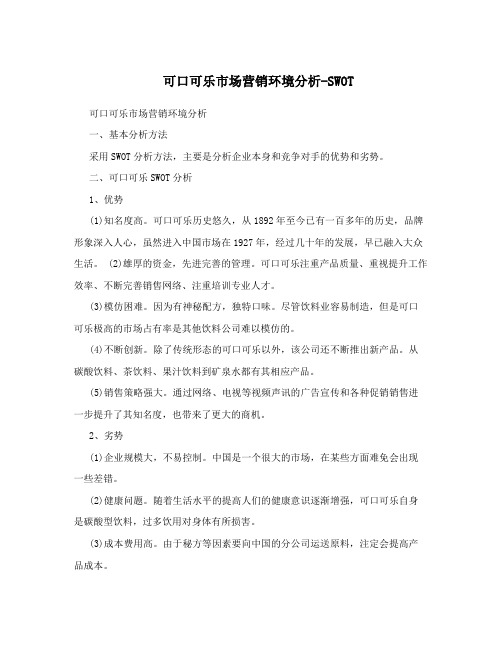
可口可乐市场营销环境分析-SWOT 可口可乐市场营销环境分析一、基本分析方法采用SWOT分析方法,主要是分析企业本身和竞争对手的优势和劣势。
二、可口可乐SWOT分析1、优势(1)知名度高。
可口可乐历史悠久,从1892年至今已有一百多年的历史,品牌形象深入人心,虽然进入中国市场在1927年,经过几十年的发展,早已融入大众生活。
(2)雄厚的资金,先进完善的管理。
可口可乐注重产品质量、重视提升工作效率、不断完善销售网络、注重培训专业人才。
(3)模仿困难。
因为有神秘配方,独特口味。
尽管饮料业容易制造,但是可口可乐极高的市场占有率是其他饮料公司难以模仿的。
(4)不断创新。
除了传统形态的可口可乐以外,该公司还不断推出新产品。
从碳酸饮料、茶饮料、果汁饮料到矿泉水都有其相应产品。
(5)销售策略强大。
通过网络、电视等视频声讯的广告宣传和各种促销销售进一步提升了其知名度,也带来了更大的商机。
2、劣势(1)企业规模大,不易控制。
中国是一个很大的市场,在某些方面难免会出现一些差错。
(2)健康问题。
随着生活水平的提高人们的健康意识逐渐增强,可口可乐自身是碳酸型饮料,过多饮用对身体有所损害。
(3)成本费用高。
由于秘方等因素要向中国的分公司运送原料,注定会提高产品成本。
3、机遇(1)中国对外政策。
中国政府支持外资企业的进入,不仅可以收到很可观的税收收入,还可以推动中国整个饮料行业的发展。
(2)公益事业。
中国毕竟还是发展中国家,很多地区的公共建设、教育建设都需要企业的支持,可口可乐公司可以通过公益事业扩大自己的影响力。
(3)中国市场巨大。
中国是一个人口大国,随着改革开放和经济的发展,人们生活水平有了很大提高,消费水平也大幅提升,势必有利于可口可乐在中国的发展。
(4)收购兼并。
虽然中国的饮料行业还在发展中,但也有很多出色的民族品牌,可以通过收购能途径打造可口可乐旗下更具中国市场特色的饮料品牌,从而进一步扩大自己的品牌形象,使之屹立不倒。
可口可乐五力模型分析心得

可口可乐五力模型分析心得
可口可乐是全球知名的饮料品牌,以下是基于五力模型的分析心得:
1. 竞争对手的力量:可口可乐面临来自百事可乐等大型跨国饮料公司的激烈竞争。
这些竞争对手拥有广泛的产品线以及全球市场份额,对可口可乐构成一定压力。
2. 供应商的力量:可口可乐的成功依赖于高质量的原材料供应商,如糖和气泡水。
然而,作为一个全球品牌,可口可乐可以通过与多个供应商建立良好的合作关系来降低供应商的议价能力,确保原材料供应的稳定性。
3. 顾客的力量:可口可乐拥有众多忠诚的消费者群体,并且通过不断的市场营销和品牌塑造来提高顾客忠诚度。
然而,消费者对健康饮食的关注逐渐增加,对含糖饮料的需求可能会受到一定程度的影响。
4. 替代品的力量:可口可乐也面临来自其他类型饮品的替代品,如茶、咖啡、果汁等。
随着消费者健康意识的增强,可口可乐需要不断创新和推出更加健康的产品,以抵抗替代品的威胁。
5. 新进入者的力量:可口可乐作为市场领导者,拥有巨大的规模经济优势和强大的品牌溢价。
这使得新进入者很难进入市场并与可口可乐竞争。
此外,行业的技术性壁垒和供应链要求也会限制新进入者的进入。
通过五力模型的分析,我们可以看出虽然可口可乐面临一些竞争和市场变化的挑战,但其品牌实力、供应链网络和市场地位使其能够保持竞争优势,并在全球范围内取得成功。
根据可口可乐公司五力模型分析

根据可口可乐公司五力模型分析引言可口可乐公司是全球领先的饮料制造商之一,拥有广泛的产品线和全球销售网络。
本文将根据可口可乐公司五力模型进行分析,以了解该公司在竞争激烈的饮料市场中的竞争地位和战略。
1. 供应商力量供应商力量是指供应商对公司采购的影响力。
对于可口可乐公司而言,其核心原料包括糖、水和添加剂等,需要从全球采购。
然而,可口可乐公司拥有庞大的采购规模和全球采购网络,使其能够与供应商进行有效的谈判并获得有利的价格和条件。
因此,供应商力量对可口可乐公司的影响较小。
2. 买家力量买家力量是指买家对公司产品价格和质量的影响力。
饮料市场存在众多竞争对手,消费者有多种选择。
然而,可口可乐公司品牌知名度高,产品质量可靠,拥有广泛的消费者基础。
通过广告和市场推广活动,可口可乐公司能够保持消费者对其产品的忠诚度,从而降低了买家力量对其的影响。
3. 竞争对手力量可口可乐公司在饮料市场面临激烈的竞争。
主要竞争对手包括百事可乐公司和其他饮料制造商。
这些竞争对手也拥有自己的产品线和市场份额。
然而,可口可乐公司通过不断创新,推出新产品,并建立良好的分销网络,在市场上保持了竞争优势。
因此,竞争对手力量对可口可乐公司的影响相对较小。
4. 替代品威胁替代品威胁是指其他可替代产品对公司产品的威胁程度。
在饮料市场,存在许多其他选择,如茶、咖啡和果汁等。
然而,可口可乐公司通过多样化的产品线和广告宣传,成功地建立了与其品牌相关的消费者忠诚度。
这降低了替代品威胁对公司的影响。
5. 新进入者威胁新进入者威胁是指其他公司进入市场对公司的冲击。
饮料市场的进入壁垒相对较高,需要大量资金和资源。
可口可乐公司作为全球领先企业,拥有庞大的资本和全球市场份额。
同时,可口可乐公司在市场上拥有强大的品牌认知度和消费者忠诚度,进一步降低了新进入者威胁。
结论根据可口可乐公司五力模型的分析,该公司在饮料市场上具有较强的竞争地位和战略。
供应商力量相对较小,买家力量受到产品质量和品牌影响的限制,竞争对手力量较弱,替代品威胁较低,新进入者威胁较小。
可口可乐市场营销推广策略分析-SWOT分析-4P战略-波特五力模型

可⼝可乐市场营销推⼴策略分析-SWOT分析-4P战略-波特五⼒模型Marketing Plan and Research Report of Coca-ColaTable of ContentExecutive summary (2)External environment analysis (2)Market strategy (6)Marketing research result (6)Marketing mix summary (7)Detailed strategy for promotion (9)Controls (11)Reference list (13)Executive summaryThe Coca-Cola Company (“Coca-Cola”)was founded in 1886 which is ranked number one in the beverage industry. The company manages more than 500 nonalcoholic beverage brands, and four of the top five nonalcoholic sparkling beverage brands are owned by Coca-Cola. According to its 2012 annual report, the whole group’s net operating revenue amounted to 48.02 billion USD (The Coca-Cola Company Annual Review, 2012). In addition, Coca-Cola accounts for approximately 37.1% of all the soft drink market, followed by PepsiCo at about 30.2%, and Dr. Pepper Snapple Group at 21.4% (Faber, 2012).In the long-standing viewpoint, Coca-Cola has an inclination to expand its market share to 50% and its sales revenue to 500 billion USD in the 2015 (Hofstede, 2012). Although its prosperous status quo, the company is also facing against an intensified competition. This report is aimed at analyzing the overall marketing strategy of Coca-Cola to find out the potential vulnerabilities. Then, based upon the analysis and in-depth research, it will outline the strategic plan for the future in order to further enhance Coca-Cola’s marketing status.External environment analysisA well-rounded analysis of company’s environment will be beneficial for the comprehensive understanding of the situation. First, it is better to research Coca-Cola’s external situation which includes three parts: macro-environmental factors, micro-environmental factors and competitive strategy.For the macro aspect, this report utilizes PEST model which examines the changes in a marketplace caused by Politics, Economy, Social and Technological factors.Political AnalysisShifts of government’s attitude towards the foreign-invested enterprise may pose a threat to the company. Especially in the emerging countries, the political stability is essential to a successful business. In addition, changes of laws and regulations, including non-alcoholic drinks regulation should be considered.Economic AnalysisAccording to IMF, while there have been some encouraging signs of economic recovery, the global economic growth seems to be losing momentum. In other words, the company still needs to be vigilant to the outside world and the emerging economy to seize opportunities.According to the Standard and Poor's Industry surveys, "For major soft drink companies, there has been economic improvement in many major international markets, such as Japan, Brazil, and Germany." These markets will continue to play a major role in the success and stable growth for a majority of the non-alcoholic beverage industry.Social AnalysisLiving a healthier lifestyle is so prevalent all around world that has affected thenon-alcoholic beverage industry as some consumers are switching to bottled water and diet colas instead of beer and other alcoholic beverages. This continued tendency will impact the non-alcoholic beverage industry by increasing the demand overall and in the healthier beverages.Technological AnalysisThe rapid advancement of science and technology may deeply impact Coca-Cola as well. For example, novel distribution channel, diversified promotion campaign and new production line etc.In terms of micro-environmental factors, it is advisable to use Porter's Five Forces model to analyze the market condition.Threat of new entrantsCompared with other industry, soft drinks industry has a relatively higher gross profit rate and lower barriers to entry, accordingly, there do exist many potential entrants. ?Threat of substitute productsAs is mentioned above, healthier drinking has been a new trend for the consumers. So, enough attention must be paid to the substitute products such as tea drinks, bottled water and sports drinks.Bargaining power of customerWith thousands kinds of non-alcoholic beverage in the market, consumers have a wide range of options. Additionally, they are also becoming sensitive to price which render them to have more bargaining power.Bargaining power of suppliersAs the leading company in the market, Coca-Cola stays strong to the suppliers who are willing to collaborate with such a giant enterprise. In other words, bargaining power of suppliers is comparatively weak.Intensity of competitive rivalryRelied upon its sales and distribution channels, Coca-Cola has undoubtedly established a mature marketing network. But what can’t be ignored is the threat s posed by companies out of carbonated beverage, they all spare no effort to gain market share in the relevant industry.After the analysis of the above two factors, keeping alert and further developing the core competency are extremely significant to Coca-Cola. Thus, how will the company compete with the major players in the market?Competitive AdvantageLower Cost DifferentiationAs can be seen in the chart, the company used differentiation and cost leadership tactics. Differentiation is achieved through superb quality of its product, which surpasses the company’s major rivals in the brand image and high customer recognition. What’s more, its promotion campaign and packaging strategy also differentiate Coca-Cola from competitors, for instance, its unique bottle design has become a world famous symbol.The positioning of cost leadership is achieved not only through economies of scale in research, development and promotion, but also through learning, knowledge and experience in production and operational processes. Furthermore, the company’s。
可口可乐公司战略分析报告(PESTN-行业环境分析-波特五力分析法-SWOT分析法)
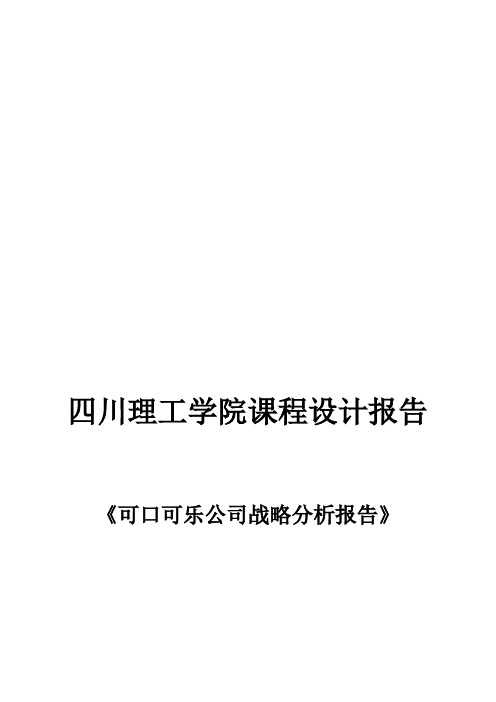
四川理工学院课程设计报告《可口可乐公司战略分析报告》专业:会计学(双)班级:2013级1班指导老师:学生:学号:2014年12月13日目录四川理工学院课程设计报告 (1)《可口可乐公司战略分析报告》 (1)一、可口可乐公司简介 (3)二、宏观环境 (4)1.政治法律环境 (4)2.经济环境 (4)3.社会文化环境 (4)4.技术环境 (5)三、可口可乐公司的竞争力模型分析 (6)1.国内饮料行业内竞争者现在的竞争能力 (6)2.潜在竞争者进入的能力 (6)3. 供应商的讨价还价能力 (7)4.购买者的讨价还价能力 (7)5.替代品的替代能力 (7)四、SWOT分析 (8)1. 优势(Strength) (8)2.劣势(Weakness ) (9)3. 机会(Opportunity) (9)4.威胁(Threat) (9)五、改善建议 (10)1.S-T—差异化战略 (10)2.S-O—扩张战略 (10)3.W-O (10)4.W-T (11)一、可口可乐公司简介世界最大的软饮料公司。
公司总部设在美国亚特兰大。
1989年资产额82.825亿美元,雇佣职工2万多人。
可口可乐公司1919年9月5日在美国特拉华州成立。
1960年进入美国最大的100家工业公司的行列;1983年居第48位。
1960~1983年,该公司的销售额、资产额和净收入的年均增长率分别为12.2%、 11.5%和12.3%。
可口可乐公司制造和分配浓缩软饮料和果汁,它的产品可口可乐是从可口和可乐两种植物的叶子和果实中取出液汁制成的一种饮料。
作为该公司主要部门的软饮料每年的销售额约占公司总销售额的80%。
软饮料产品占公司总利润的 88%。
可口可乐美国公司(CoCa-Cola USA)是可口可乐公司最大的销售商;该公司食品部制造和销售冷冻、浓缩柑橘和各种果汁、柠檬晶、咖啡和茶。
酒类部门生产和销售各种牌号的酒,主要销于国内市场,是美国第四家最大的酒类生产和销售者;该公司还生产塑料薄膜以及其他消费产品如防臭剂、湿手巾纸等。
可口可乐4P分析
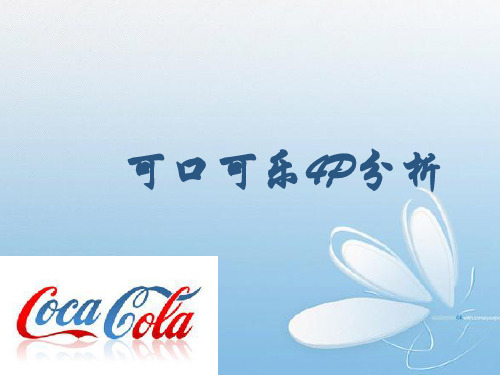
三.分销(Place)
可口可乐在中国采用的分销策略是广泛性分销策略。广 泛性分销策略是指在同一渠道层次使用尽可能多的中间 商分销其产品。我们都知道可口可乐先后采用了3A到3P 的分销策略。3A当中的一A(Availability)就是“买得 到”——使得可口可乐产品随处都能买的到。后来为了 适应消费者的需求,可口可乐又提出了3P的分销策略。 3P中的一P(Pervasive)就是无处不在——使得可口可 乐产品随手可得。为了做到这一点,可口可乐始终秉承 一个理念——决不放弃任何一个小的零售商,哪怕是最 小型夫妻店。所以,不管你是在大型的超市,商场,还 是在偏僻的小镇,你都可以买到可口可乐产品。
除了可口可乐外,其他三个主要的国际品牌和众多其他品 牌的产品包装下都注明“可口可乐公司荣誉出品”字样。 可口可乐公司的这种多品牌战略是以可口可乐这一强势品 牌为核心,雪碧、健怡可口可乐、芬达为二线保护产品, 其他品牌为第三线的补充产品,组建其品牌家族。这种品 牌结构的主要优势在于三线品牌之间保持着相对合理的品 牌距离,使得他们既可以相互支持和保护,一荣俱荣;又 可以适当的规避品牌间的连带风险,不至于一损俱损。
可口可乐旗下部分产品的组合示意图:
可口可乐的产品市场分析策略示意图:
在可口可乐奥运互联网营销中,
为庆祝奥运会到来而特别推出系列 纪念包装——七款印有奥运城市地 标性建筑的“可口可乐奥运城市纪 念包装”即将在全国新装上市。这 一系列的纪念包装不仅延续了可口 可乐“畅爽开始”的设计理念,即 五彩缤纷的图案从可口可乐瓶中涌 现而出,而且每款包装的主画面都 由奥运承办城市的标志性建筑及当 地承办的体育项目相关元素组成, 让广大消费者可以在体验奥运畅爽 的同时,留下终生难忘的纪念。
可口可乐营销战略和策略分析
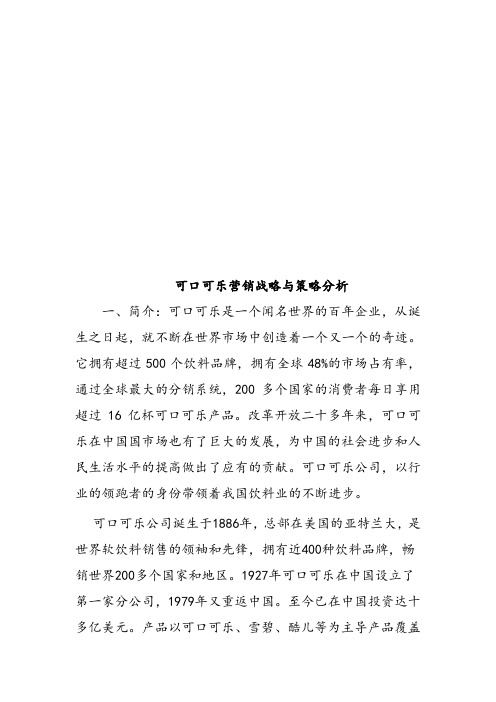
可口可乐营销战略与策略分析一、简介:可口可乐是一个闻名世界的百年企业,从诞生之日起,就不断在世界市场中创造着一个又一个的奇迹。
它拥有超过500个饮料品牌,拥有全球48%的市场占有率,通过全球最大的分销系统,200多个国家的消费者每日享用超过16亿杯可口可乐产品。
改革开放二十多年来,可口可乐在中国国市场也有了巨大的发展,为中国的社会进步和人民生活水平的提高做出了应有的贡献。
可口可乐公司,以行业的领跑者的身份带领着我国饮料业的不断进步。
可口可乐公司诞生于1886年,总部在美国的亚特兰大,是世界软饮料销售的领袖和先锋,拥有近400种饮料品牌,畅销世界200多个国家和地区。
1927年可口可乐在中国设立了第一家分公司,1979年又重返中国。
至今已在中国投资达十多亿美元。
产品以可口可乐、雪碧、酷儿等为主导产品覆盖碳酸饮料、果汁饮品、汽水、茶饮料等几大领域。
可口可乐公司在中国软饮料市场上占主导地位。
二、可口可乐的市场营销环境分析(1)宏观环境分析1、软饮料在中国的发展趋势。
中国软饮料市场的发展是从20世纪八十年代开始的。
时至今日,已经成长为一个庞大、成熟的市场。
近年来,随着经济的快速增长和城乡消费者收入水平和消费能力的持续提高,促使饮料消费需求始终处于较快增长的阶段。
中国软饮料年产量以超过20%的年均增长率递增,扩大可口可乐在中国的销售范围,扩大可口可乐在中国的影响,自然就增加了销售额。
2、人口结构。
有人才有消费者,才有产品的销路。
人口的结构对于每一个产品来说,都有着密切的关系。
根据资料显示,中国人口老龄化趋势严重,49后的即将退休,49后是中国人口数量较大的一批人,但是对可口可乐的认知度还较低,不过在大环境的影响下认知度已经大为提高。
中国的新生代,在对外交流越加频繁的现在,他们对外来文化的认知度也较高。
对可口可乐的认知度也是较强的,只要继续保持就行了。
3、经济状况。
如果,一个国家的经济发展水平低,人民的生活都成问题,那么,其他的消费品就更加不可能被消费。
可口可乐SWOT分..
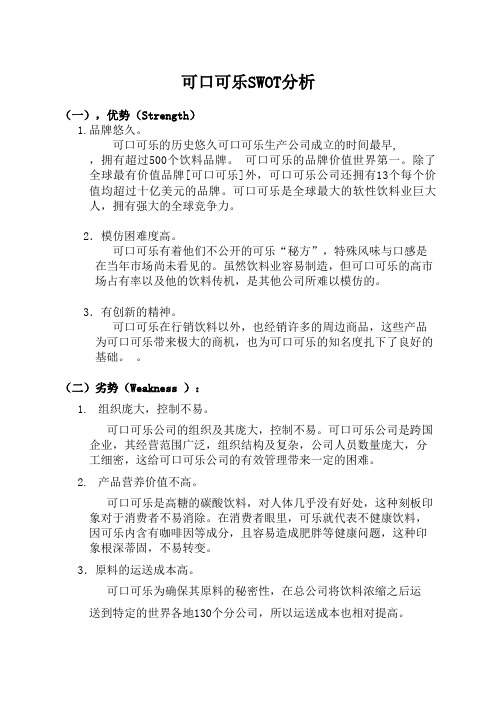
可口可乐SWOT分析(一),优势(Strength)1.品牌悠久。
可口可乐的历史悠久可口可乐生产公司成立的时间最早,,拥有超过500个饮料品牌。
可口可乐的品牌价值世界第一。
除了全球最有价值品牌[可口可乐]外,可口可乐公司还拥有13个每个价值均超过十亿美元的品牌。
可口可乐是全球最大的软性饮料业巨大人,拥有强大的全球竞争力。
2.模仿困难度高。
可口可乐有着他们不公开的可乐“秘方”,特殊风味与口感是在当年市场尚未看见的。
虽然饮料业容易制造,但可口可乐的高市场占有率以及他的饮料传机,是其他公司所难以模仿的。
3.有创新的精神。
可口可乐在行销饮料以外,也经销许多的周边商品,这些产品为可口可乐带来极大的商机,也为可口可乐的知名度扎下了良好的基础。
(二)劣势(Weakness ):1.组织庞大,控制不易。
可口可乐公司的组织及其庞大,控制不易。
可口可乐公司是跨国企业,其经营范围广泛,组织结构及复杂,公司人员数量庞大,分工细密,这给可口可乐公司的有效管理带来一定的困难。
2.产品营养价值不高。
可口可乐是高糖的碳酸饮料,对人体几乎没有好处,这种刻板印象对于消费者不易消除。
在消费者眼里,可乐就代表不健康饮料,因可乐内含有咖啡因等成分,且容易造成肥胖等健康问题,这种印象根深蒂固,不易转变。
3.原料的运送成本高。
可口可乐为确保其原料的秘密性,在总公司将饮料浓缩之后运送到特定的世界各地130个分公司,所以运送成本也相对提高。
三,机会(Opportunity):1.独特的吸引力。
碳酸饮料符合年轻族群需求,年轻人是主要目标客户,年轻人所占的比例越来越大,带给业者的商机很大。
饮料品牌形象影响销售状况很深。
美国的速食文化与碳酸饮料十分契合。
2.市场占有率高。
可口可乐的全球市场占有率具有50%,他们不断挺进世界各国。
可口可乐系列产品在中国饮料市场的占有率目前已超过了55.3%。
3.赞助奥运会与公益活动。
奥运会是全世界的活动,可口可乐赞助奥运,使自己的品牌得以名扬国际,成功的广告再次为可口可乐加分,除此之外可口可乐中国系统在中国长期以来不遗余力地支持各种全国性和地区性社会公益事业,捐资总额超过7,000万人民币。
- 1、下载文档前请自行甄别文档内容的完整性,平台不提供额外的编辑、内容补充、找答案等附加服务。
- 2、"仅部分预览"的文档,不可在线预览部分如存在完整性等问题,可反馈申请退款(可完整预览的文档不适用该条件!)。
- 3、如文档侵犯您的权益,请联系客服反馈,我们会尽快为您处理(人工客服工作时间:9:00-18:30)。
Marketing Plan and Research Report of Coca-ColaTable of ContentExecutive summary (2)External environment analysis (2)Market strategy (6)Marketing research result (6)Marketing mix summary (7)Detailed strategy for promotion (9)Controls (11)Reference list (13)Executive summaryThe Coca-Cola Company (“Coca-Cola”)was founded in 1886 which is ranked number one in the beverage industry. The company manages more than 500 nonalcoholic beverage brands, and four of the top five nonalcoholic sparkling beverage brands are owned by Coca-Cola. According to its 2012 annual report, the whole group’s net operating revenue amounted to 48.02 billion USD (The Coca-Cola Company Annual Review, 2012). In addition, Coca-Cola accounts for approximately 37.1% of all the soft drink market, followed by PepsiCo at about 30.2%, and Dr. Pepper Snapple Group at 21.4% (Faber, 2012).In the long-standing viewpoint, Coca-Cola has an inclination to expand its market share to 50% and its sales revenue to 500 billion USD in the 2015 (Hofstede, 2012). Although its prosperous status quo, the company is also facing against an intensified competition. This report is aimed at analyzing the overall marketing strategy of Coca-Cola to find out the potential vulnerabilities. Then, based upon the analysis and in-depth research, it will outline the strategic plan for the future in order to further enhance Coca-Cola’s marketing status.External environment analysisA well-rounded analysis of company’s environment will be beneficial for the comprehensive understanding of the situation. First, it is better to research Coca-Cola’s external situation which includes three parts: macro-environmental factors, micro-environmental factors and competitive strategy.For the macro aspect, this report utilizes PEST model which examines the changes in a marketplace caused by Politics, Economy, Social and Technological factors.•Political AnalysisShifts of government’s attitude towards the foreign-invested enterprise may pose a threat to the company. Especially in the emerging countries, the political stability is essential to a successful business. In addition, changes of laws and regulations, including non-alcoholic drinks regulation should be considered.•Economic AnalysisAccording to IMF, while there have been some encouraging signs of economic recovery, the global economic growth seems to be losing momentum. In other words, the company still needs to be vigilant to the outside world and the emerging economy to seize opportunities.According to the Standard and Poor's Industry surveys, "For major soft drink companies, there has been economic improvement in many major international markets, such as Japan, Brazil, and Germany." These markets will continue to play a major role in the success and stable growth for a majority of the non-alcoholic beverage industry.•Social AnalysisLiving a healthier lifestyle is so prevalent all around world that has affected thenon-alcoholic beverage industry as some consumers are switching to bottled water and diet colas instead of beer and other alcoholic beverages. This continued tendency will impact the non-alcoholic beverage industry by increasing the demand overall and in the healthier beverages.•Technological AnalysisThe rapid advancement of science and technology may deeply impact Coca-Cola as well. For example, novel distribution channel, diversified promotion campaign and new production line etc.In terms of micro-environmental factors, it is advisable to use Porter's Five Forces model to analyze the market condition.•Threat of new entrantsCompared with other industry, soft drinks industry has a relatively higher gross profit rate and lower barriers to entry, accordingly, there do exist many potential entrants. •Threat of substitute productsAs is mentioned above, healthier drinking has been a new trend for the consumers. So, enough attention must be paid to the substitute products such as tea drinks, bottled water and sports drinks.•Bargaining power of customerWith thousands kinds of non-alcoholic beverage in the market, consumers have a wide range of options. Additionally, they are also becoming sensitive to price which render them to have more bargaining power.•Bargaining power of suppliersAs the leading company in the market, Coca-Cola stays strong to the suppliers who are willing to collaborate with such a giant enterprise. In other words, bargaining power of suppliers is comparatively weak.•Intensity of competitive rivalryRelied upon its sales and distribution channels, Coca-Cola has undoubtedly established a mature marketing network. But what can’t be ignored is the threat s posed by companies out of carbonated beverage, they all spare no effort to gainmarket share in the relevant industry.After the analysis of the above two factors, keeping alert and further developing the core competency are extremely significant to Coca-Cola. Thus, how will the company compete with the major players in the market?Competitive AdvantageLower Cost DifferentiationAs can be seen in the chart, the company used differentiation and cost leadership tactics. Differentiation is achieved through superb quality of its product, which surpasses the company’s major rivals in the brand image and high customer recognition. What’s more, its promotion campaign and packaging strategy also differentiate Coca-Cola from competitors, for instance, its unique bottle design has become a world famous symbol.The positioning of cost leadership is achieved not only through economies of scale in research, development and promotion, but also through learning, knowledge and experience in production and operational processes. Furthermore, the company’sefficient distribution networks and manufacturing systems contribute significantly to its cost saving..Market strategyBased on the above analysis, this report researches the interior part of Coca-Cola to determine its marketing and financial objectives, segmentation, positioning, and target market(s) in the future.Future growth for Coca-Cola will be embodied in two main areas: global emerging market health drinks. Besides United States Coca-Cola will continue to market to countries around the world. The company has an impressive performance in emerging markets like Latin America, the BRIC, and Western Europe which will be their major focus in the future for this is where major growth opportunities lie.In addition, consumers are moving towards a healthier lifestyle, which accordingly is causing Coca-Cola to expand product line to satisfy their needs. This new market is huge and creates a lot of growth opportunity for Coca-Cola.More specifically, Coca-Cola intends to increase its current market share in the soft drink to 50% in the end of 2015 (Hofstede, 2012), in particular, it will invest heavily in the health drink product to grab this developing cliché market and to cater for consumer’s aptitude. Then, the whole group will achieve 50 billion USD sales revenue and 13 billion USD profit margin (Marcial, 2007).Marketing research resultTo stay competitive, Coca-Cola has done well in understanding and satisfying consumers. It have been found that customers expect more from their beverages. To fill this desire Coca-Cola has developed the Beverage Institute for Health and Wellness. This institute develops new product ideas that can contribute to their product line. In addition, Coca-Cola is capable of maintaining their market vitality, so they continue to do research that will benefit their consumers, as well as being profitable for the company.Apart from flavor diversification, profitability in certain region has also been a major consideration. For instance, Coke Zero is a product that carries no carbohydrates orcalories and was not quite meeting the expected profits in the United States, but Coca-Cola started to advertise it more in Europe to areas that to enjoy it. This region seemed more concerned about their health and well-being, which contributed to Coke Zero becoming more of a profitable product.Special marketing techniques such as B2B strategies are also used to make their products more attractive to the young people. For example, Coca-Cola united with iTunes, so that whenever someone purchased a Coca-Cola product they would receive free songs to promote both products (Fuhrman, 2007).Even though, Coca-Cola is confronting with a number of challenges in the days to come. The most striking one is that the beverage industry is moving toward a health conscious consumer. “ In many European countries, the increasing consumer trend toward a healthier lifestyle continues to grow demand for functional beverages that offer physical or mental well-being, lower calories and other added values” (Fuhrman, 2007). Consumers’ value products that are going to help them live a healthy lifestyle and feel better both physically and mentally. Coca-Cola has to reconsider its existing product, pricing, distribution channel and promotion strategy to better adapt itself to the ever-changing atmosphere.In order to formulate a well-rounded market strategy for Coca-Cola, this report carefully establishes the relevant tactics which are in line with the analysis and data collected. It is recommended to use 4P which consists of product, place, price, promotion to analyze the specific details in the next part.Marketing mix summaryIn this report, 4P model is utilized to illustrate Coca-Cola’s marketing mix, i.e. product, place, price, promotion.Item DetailsProduct Coca-Cola has a huge product mix which contains about 400 brands, including diet and light beverages, waters, juice and juice drinks, teas,coffees, energy, and sports drinks (Coca-Cola Company, 2012).To attract new consumers and markets, product line must be extended,especially in the health drink product like tea, juice and sports drinketc.In addition, proper modification for the current product is also neededto maintain the current consumers.Price With the careful consideration of consumer’s price elasticity, the prices of the Coca-Cola's Companies products vary according to thebrand and the size in which they come in (Coca-Cola Company,2012). Different region has differed preference and sensitivity to price.The distributors and retail stores that the Coca-Cola Company dealswith should implement their own pricing strategy to gain the bestprofit margin within an accepted sales volume.Promotion There are four major parts of the promotional mix that integrate together to create a competitive advantage for an organizationincluding advertising, public relations, sales promotion, and personalselling.Ads: Coca-Cola has invested heavily on advertising. The mainpurpose of ads are maintaining of brands awareness. Then, the ads inthe future should focus on health conscious and environmentallyfriendly to cater for the existing trend.Public relation: Product placements and sponsorships are frequentlyused by Coca-Cola (Marcial, 2007). Positive spokesperson to appealto the younger generation is another effective tool to publicize (Truini,2007)Personal selling: Personal selling in the Coca-Cola Company often isdone in a business-to-business fashion. This can be used in bigbusiness alliance to satisfy consumers’ diversified needs.Sales promotion: coupons and rebates can be often used because theyare more likely to influence customers’ buying decision. Another typeof sales promotion that the Coca-Cola Company is currently using istheir coke rewards points promotion.Place Coca-Cola Company also uses intensive distribution strategies to make sure their products can be available everywhere. Moreover,automatic vending machines are effective to extend distributionnetwork. To cope with the changing diet conception, Coca-Colashould focus more on Coca-Cola’s Diet Coke and Coke Zero sales,especially in Latin America, the BRIC, and Western Europe (Fuhrman,2007).Detailed strategy for promotionOnly with superior product, efficient distribution network and sufficient inventory is far from a successful business. Promotion is the key element of the marketing mix designed to build a useful channel with the marketplace and to persuade the customers buying decision. The promotional mix is the combination of personal selling, advertising, sales promotion and public relations that it uses in its marketing plan.•AdvertisingThe Coca-Cola’s innovative ads are extremely impressive to consumers. So, next step, what the company should do is keep this unique advantage and focus much more on the localization with respect to different culture background. This can be contributable to develop the emerging market.•Public relationSponsorship in the sport area has been successful in the last few decades and left a positive brand image. To comply with the healthy trend, Coca-Cola needs to invest more in public benefit activities, for instance, giving sponsor Hope Primary School, making contributions to medical treatment cause. These activity may establish a positive image in all kinds of people.•Personal selling & sales promotionThe negative implication of several media has exerted a relatively profound impact upon carbonated beverage. Accordingly, juice, tea and sports drinks should be the main products for promotions. The company can improve health drink market share by using more personal selling booth and more sales discount or lottery coupon. These activities are effective for getting people's short-term attention.Survey experiment in the Fenwick’s department store also proved the above analysis.In the survey of consumers’ attitudes towards health consideration when purchasing drinks, more than 45% agree with the viewpoints (as is shown in the bar chart below).In addition, when asked about familiarity, 50% agree with that it plays a major role in purchasing decision.ControlsImplementationImplementation is the process on how well the business mixes its people, organizational structure and company culture into a cohesive program that supports the marketing plan (Clark, 2005).Coca-Cola should implement several major transformations. First, production capability need to be modified to meet the quota demanded. It must also be cost-effective to avoid inventory stocks wastes. The marketing team should be aware of knowledgeable management about the product. The styles and types of promotion must be appealing to target customers to obtain the potential amount of exposure for the product. Another thing is efficient distribution network. The pertinent issue is taken care of with expedient transportation routes to commercial areas and traffic.Monitoring And ControllingMonitoring and controlling allows Coca-Cola to take the necessary actions to meetthe marketing goals. There are three methods Coca-Cola may use to monitor the marketing scheme.•Sales AnalysisThe sales analysis analyzes sales revenue by market segmentation to discover advantages and disadvantages in the different regions. Sellers of Coca-Cola products vary from big retail supermarkets to small corner stores. This tool gives the products maximum exposure to customers at their convenience.•Market Share AnalysisThis approach is a comparison to the major rivals in the relevant market. With the shifts Coca-Cola is currently undergoing, they aim to get an aggressive position to stable its strong power. Target market various age groups and lifestyles from high school students too universities, and male or female.•Marketing Profitability AnalysisThis method takes the cost factor into consideration which deem profitability as a key index. Three ratios can be used for supervising marketing profitability; they are market research to sales, advertising to sales and sales representatives to sales. These three indicators can assist Coca-Cola determine any developing tendency, such as the requirement for a novel product. Scientific and careful comparison of these outcomes with actual results offers the company a clear instruction.Reference listAlarcon, Camille. (2007, January). Coke grows from zero to hero. B & T Weekly, 6-7 McKenzie, M., Linden, R. W. A., & Nicholson, J. W. (2009). The effect of Coca-Cola and fruit juices on the surface hardness of glass–ionomers and ‘compomers’.Journal of Oral Rehabilitation, 31(11), 1046-1052.Belch, G. E., Belch, M. A., Kerr, G. F., & Powell, I. (2008). Advertising and promotion: An integrated marketing communications perspective. McGraw-Hill. Clark, Nicola. (2005). PowerAde eyes feminine appeal. Marketing, 16-17Flagg, Michael. (2002). Pepsi Siphons Off Some of Coke's Lead In China by Learning to Pick Its Battles. Wall Street Journal (Eastern Edition), 23(5), 12-13. Fuhrman, E. (2007, September). Western Europe: A mature market. Beverage Industry, 98(9), 24-26.De Mooij, M. & Hofstede, G. (2010). Convergence and divergence in consumer behavior: implications for international retailing. Journal of retailing, 78(1), 61-69.Harnack, L., Stang, J., & Story, M. (2004). Soft drink consumption among US children and adolescents: nutritional consequences. Journal of the American Dietetic Association, 99(4), 436-441.MacArthur, Kate and Thompson, Stephanie. (2006). Pepsi, Coke: We satisfy your 'need states'. Advertising Age, 77(3), 54-56.Marcial, G. (2007). Coke Sparkles Again. Business Week,15(2), 51-53.The Coca-Cola Company 2012 Annual Review, 12-15Truini, J. (2007). Beverage maker plans biggest plastics plant. Waste News, 13. (10), 4-4.Tucker, W. T. (2006). The development of brand loyalty. Journal of Marketing Research, 32-35.。
